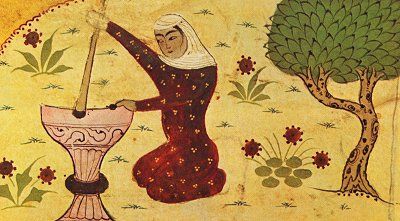
(from a medieval Persian dictionary)
Wikimedia Commons public domain
I’m beginning to write up a brief introductory discussion of the great early Muslim mystic Rābiʿa al-‘Adawiyya al-Qaysiyya. In order to do so, I’m drawing first upon the discussion of her that is given by the late British scholar Margaret Smith (1886-1970) in Muslim Women Mystics: The Life and Work of Rābiʿa and Other Women Mystics in Islam (Oxford: Oneworld, 2001). Here are a handful of my notes:
In the history of Islám, the woman saint made her appearance at a very early period, and in the evolution of the cult of saints by Muslims, the dignity of saintship was conferred on women as much as on men. As far as rank among the “friends of God” was concerned, there was complete equality between the sexes. (19)
So the title of saint was bestowed upon women equally with men, and since Islám has no order of priesthood and no priestly caste, there was nothing to prevent a woman from reaching the highest religious rank in the hierarchy of Muslim saints. (20)
The [medieval] biographies of the Muslim saints . . . are full of the mention of women Ṣúfís, their saintly lives, their good deeds, and their miracles. (20)
The high position attained by the women Ṣúfís is attested further by the fact that the Ṣúfís themselves give to a woman the first place among the earliest Muḥammadan mystics and have chosen her to represent the first development of mysticism in Islam.
This was the saintly Rábi‘a, a freedwoman of the Ál-‘Atík, a tribe of Qays b. ‘Adí, from which she was known as al-‘Adawiyya or al-Qaysiyya, and also as al-Baṣriyya, from her birthplace. (21))
One modern writer says of her that “Rábi‘a is the saint par excellence of the Sunnite hagiography” (21).
Her great but unfortunately much later biographer Farīd al-Dīn ‘Aṭṭār (ca. AD 1145-1221) refers to her as
That one set apart in the seclusion of holiness, that woman veiled with the veil of religious sincerity, that one on fire with love and longing, that one enamoured of the desire to approach her Lord and be consumed in His glory, that woman who lost herself in union with the Divine, that one accepted by men as a second spotless Mary — Rábi‘a al-‘Adawiyya, may God have mercy upon her. If anyone were to say, “Why have you made mention of her in the class of men?” I should say . . . “God does not look upon the outward forms.” (21)












